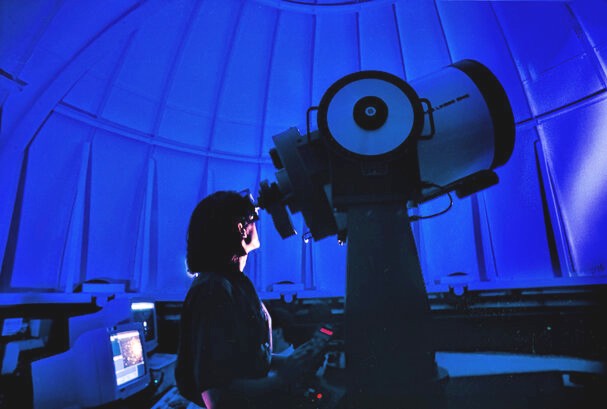
Astronomical dome at the University of Oxford, which is among the leading institutions in the Nature Index Annual Tables 2021.
Credit: James King-Holmes / Alamy Stock Photo
Nature Index Annual Tables 2021: Country comparisons in a difficult year
China’s losses are seven other nations’ gains.
20 May 2021

James King-Holmes / Alamy Stock Photo
Astronomical dome at the University of Oxford, which is among the leading institutions in the Nature Index Annual Tables 2021.
The first year of the COVID-19 pandemic brought an end to China’s run of high growth in output in the Nature Index. By contrast, most other leading locations slowed or reversed declines of the previous four years, the Nature Index Annual Tables 2021 show.
The Nature Index tracks locations and institutions producing high-quality natural-sciences research by measuring their publication outputs in 82 selected journals covering life sciences, physical sciences, chemistry, and Earth and environmental sciences.
These journals were chosen by committees made up of 58 leading researchers in the natural sciences, who were asked to nominate the publications in which they would most like to publish their best work. Their selections were validated by a survey of more than 6,000 scientists from around the world.
Nature Index’s signature metric is Share1, a fractional count based on an institution’s or location’s contribution to an article. Adjusted Share is used when comparing data over time, to take account of a small variation in the number of articles published in the Nature Index journals year by year.
After growing 15.5% from 2018 to 2019, China’s adjusted Share in the Nature Index slowed to a 1.1% increase from 2019 to 2020, by far its slowest growth since at least 2015.
But in the competition to publish in high-quality journals, China’s losses were other countries’ gains: seven other countries among the ten global leaders in the Nature Index recorded either slower declines or a turnaround to positive growth in 2020.

Source: Nature Index
Japan’s adjusted Share increased by 4.2%, for example, a turnaround from negative growth in each of the previous four years, while the United States’ rate of decline slowed from 4.4% to 1.3%. Germany and South Korea were the only other countries among the ten leaders to show growth, of 0.5% and 2% respectively, though in South Korea’s case growth was slower than the previous year.
Also, after growing by more than 10% each year on average from 2015-2019, articles with co-authors from the US and China collapsed to zero growth in 2020.
Cong Cao, a science policy expert at the University of Nottingham Ningbo, China, says this is due to a US crackdown on national security grounds on non-disclosure of foreign ties by US researchers on federally-funded grants, leading researchers to shy away from collaborations with China.
Among individual institutions, the University of Cambridge, UK, and the University of Tokyo, Japan, both re-entered the leading ten, while the top five global leaders kept the same spots they have held since 2017.
The Chinese Academy of Sciences holds a seemingly unassailable lead with a Share of 1886.71, more than twice that of its nearest competitor, Harvard University with 927.26.
In order, the Max Planck Society, French National Centre for Scientific Research and Stanford University, continue to round out the top five.

Source: Nature Index
The University of Cambridge, which fell from 9th to 14th place between 2018 and 2019, recovered to 10th position in 2020, displacing the University of Science and Technology China, which slipped from 8th to 11th.
The University of Tokyo gained three places to regain the 8th position it held in 2018 among the leading global institutions for output in the Nature Index as measured by Share.
The top rising institutions in the index in 2020 were more evenly spread between countries than in recent years, with eight countries represented among the ten institutions with the greatest Share increases in 2020. The previous year, eight of the ten institutions with the biggest gains were on the Chinese mainland. (See our coverage of the Nature Index Annual Tables 2021 Rising Stars.)
David Swinbanks, Founder of the Nature Index, said the Annual Tables results showed resilience in the research sector during a difficult year, with many institutions either maintaining or advancing their natural sciences output. Also evident was “the adaptability of institutions, and regions, to quickly perform extremely well alongside some of their more established and larger peers in challenging conditions.”
Although, due to the lengthy publication process, it would normally take two to three years for any downturn in research to be evident in article output, Swinbanks said a surge in COVID-19-related articles published more rapidly than usual may partly explain the resilience in publication numbers.
He noted that although the Annual Tables are a good indicator of high quality research output in the natural sciences, other metrics that encompass research fields beyond the natural sciences and additional scientific outputs such as data, software and intellectual property should also be considered in any assessment of research quality and institutional performance.
1. Nature Index’s signature metric, Share, is a fractional count for an article allocated to an institution, city or country/territory, that takes into account the proportion of authors on the article whose institutional affiliation is with that institution or location. Adjusted Share takes account of a small annual variation in the total number of articles in the Nature Index. For further explanation, please see natureindex.com/glossary
Editor’s note: The Nature Index is one indicator of institutional research performance. The metrics of Count and Share used to order Nature Index listings are based on an institution’s or country’s publication output in 82 natural-science journals, selected on reputation by an independent panel of leading scientists in their fields. Nature Index recognizes that many other factors must be taken into account when considering research quality and institutional performance; Nature Index metrics alone should not be used to assess institutions or individuals. Nature Index data and methods are transparent and available under a creative commons licence at natureindex.com.
